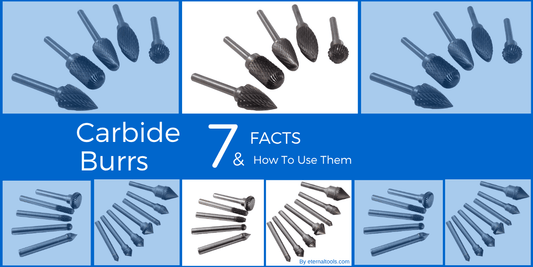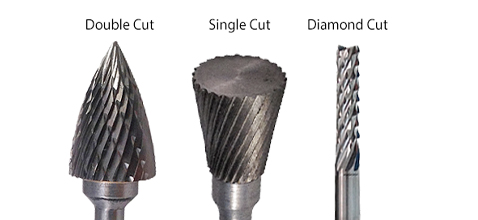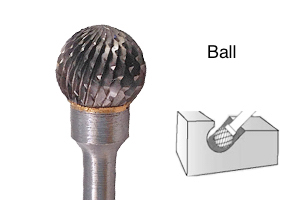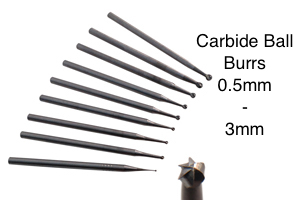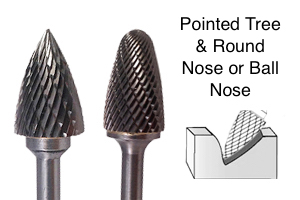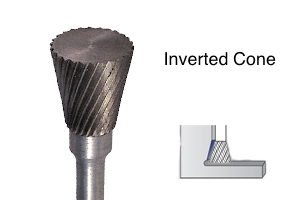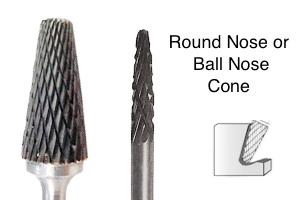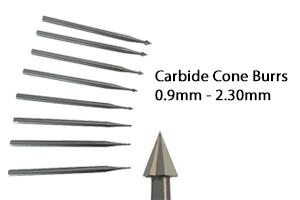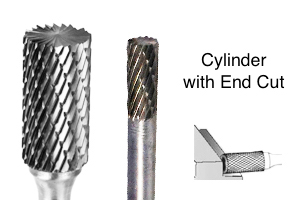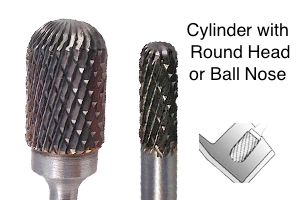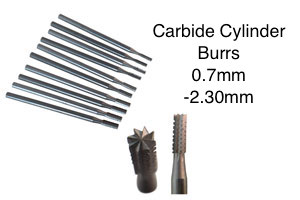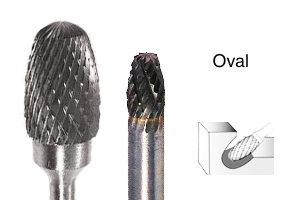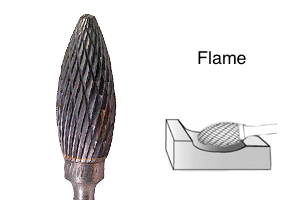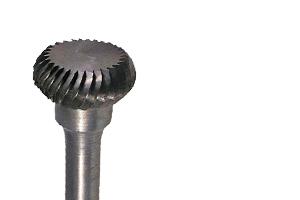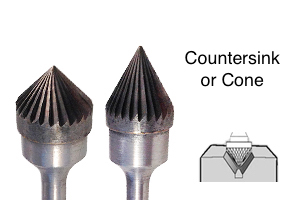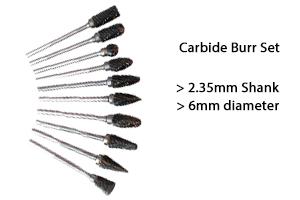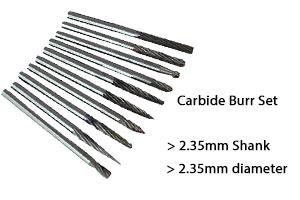What are Burrs?
Carbide Rotary Burrs, also known as die grinder bits or rotary files, are essential tools for cutting, shaping, grinding, and removing sharp edges or excess material from a wide variety of surfaces.(deburring).
Whether you're a metalworker, woodcarver, jeweller, engineer or DIY enthusiast, carbide burrs offer precision, durability, and versatility for countless applications.
In this guide, we’ll show you how to choose the right burr for the job, what tools to use them in, how to work safely and efficiently, and how to get the best results across different materials and shapes.
Helpful note: When drilling into hard metals like stainless steel or titanium, carbide micro drills are ideal due to their strength and precision.
For cutting slots, routing, profiling, contouring, counter-boring, and reaming you would use a carbide end mill, carbide slot drill or a carbide router. For cutting and shaping stone or glass you would use a Diamond Burr.
1. Carbide Burrs Can be Used on Many Materials
Die grinder bits can be used on a multitude of materials: metals including steel, aluminium and cast iron, all types of wood, acrylics, fibreglass and plastics. Tungsten Carbide burrs are also perfect for working on softer metals such as gold, platinum and silver as they last a long time with no chipping or breaking.
Certain types of stone or fossils such as Whitby Jet can also benefit from the use of tungsten carbide burr bits, but these are the exception, and the rule would usually be of its stone, use diamond burrs.
- Steel, Carbon Steel & Stainless Steel
- Cast Iron
- Aluminium
- Titanium
- Cobalt
- Nickel
- Soft metals such as Gold, Platinum & Silver
- Ceramics
- Fibreglass
- Plastic, Carbon Fiber Reinforced Plastic (CRP), Glass Fibre Reinforced Plastic (GRP)
- Brass, Copper & Bronze
- Zinc
- Wood; soft wood and hard wood
Different cuts of tungsten carbide burs are best suited to certain materials, see the next point below to find out about the different cuts.
What Do You Use Carbide Burrs or Die Grinder Bits In?
Yes, the clue is in the title...Ideally, solid carbide burrs are used in Air Tools i.e. Die Grinders, Pneumatic rotary tools and high speed engravers. Micro Motors, Pendant Drills, Flexible Shafts, and hobby rotary tools such as a Dremel.
Helpful note: Always use a handpiece that runs true (with no wobble)
Who Uses Carbide Burrs?
Carbide burrs are widely used for metalwork, tool making, engineering, model engineering, wood carving, jewellery making, welding, chamfering, casting, deburring, grinding, cylinder head porting and sculpting.
They are used in the aerospace, automotive, dental, metal sculpting, and metal smith industries; to name but a few.
2. Carbide Burrs Commonly Come in Two Cuts; Single Cut and Double Cut
Single cut (one flute) carbide burrs have a right-handed (Up cut) spiral flute. These tend to be used with stainless steel, hardened steel, copper, cast iron, and ferrous metals and will remove material quickly. Use for heavy stock removal, milling, deburring and cleaning.
- Heavy removal of material
- Milling
- Deburring
- Cleaning
- Creates long chips
Double cut (2 flutes cut across each other) carbide burrs tend to be used on ferrous and non-ferrous metals, aluminium, soft steel and also for all non-metal materials such as plastics and hard wood. They have more cutting edges and will remove material faster, leaving a smoother finish than a single cut due to producing smaller chips as they cut away the material. So this will give you a medium-light stock removal. These are the most popular cut and will see you through most applications.
Double-cut burrs for use on non-ferrous materials and plastics tend to have wide chip space and are often referred to as Aluminum cut.
Similar to double cut are Diamond Cut carbide burrs which have multiple cutting faces, often found on router end mills.
- Medium-light removal of material
- Deburring
- Fine finishing
- Cleaning
- Smooth finish
- Creates small chips
The below image indicates the double cut, single cut and again, the double cut or diamond cut.
There is also a cutter known as a left-hand cut carbide burr which you would use if you needed to reverse the rotation of the burr due to a double angle for instance.
Shank Diameter Sizes of Your Carbide Burrs:
The shank is the mount or spindle of your burr that fits into your rotary tool, die grinder, CNC machines, micro motor etc; so to make it clear, it is the opposite end to the working part of the tool. These will be labelled in inches or millimetres, i.e. a 1/4 inch shank (") or a 6 millimetre shank (mm) These are usually found in the following shank sizes:
- 1.6mm or 1/16"
- 2.35mm or 3/32"
- 3mm or 1/8"
- 6mm or 1/4"
Long shank carbide burrs can also be found, and these are great for detailed carving in hard-to-reach areas of your work.
Head Diameter Sizes:
Typically carbide cutters come in standard diameter head sizes such as these:
- 2.35mm (3/32") diameter carbide burrs
- 3mm (1/8") diameter carbide burrs
- 6mm (1/4") diameter carbide burrs
- 10mm diameter carbide burrs
- 12mm diameter carbide burrs
- 16mm diameter carbide burrs
- 20mm diameter carbide burrs
3. The Various Shapes of Carbide Burrs and How To Use Them
Deciding on what shape to use will depend on the profile or cut you are looking to achieve.
These differently shaped burs will get into many a nook and cranny and produce some interesting profiles.
3.1 Carbide Ball Burrs
Use a ball or spherical-shaped carbide burr to create concave cuts in your material or to shape and hollow out an area. Small carbide ball burrs from as tiny as 0.5mm in diameter are ideal for intricate carving projects. Many wood carvers, stone carvers and metal engravers use these carbide carving burrs in a hobby drill, micro motor or a high-speed handpiece. As we mentioned before, make sure to use a rotary handpiece that runs true. i.e with no wobble.
3.2 Carbide Tree Burrs
Use for rounding off edges and making concave cuts. Use the pointed end for cutting in hard-to-reach areas and acutely angled contours.
3.3 Carbide Inverted Cone Burrs
Use inverted cone shaped tungsten carbide burrs for making v-cuts and rear side chamfering.
3.4 Carbide Pointed Cone & Carbide Round Nose or Ball Nose Burrs
Good for rounded edges and surface finishing in difficult-to-reach areas or tight and narrow angles and contours. The round nose or ball nose cone is often referred to as a taper shape.
3.5 Cylinder Burrs. Round Nose/Ball nose/End Cut
Choose from an end-cut cylinder (with a cutting edge on the end) for contour finishing. Cylinder without end cut (flat on the end and no cutting edge) for contour finishing and right-angled corners or a round nose or ball nose shape which is a cylinder-shaped carbide burr but with a rounded head.
3.6 Oval Burrs
3.7 Flame Burrs
3.8 Oblate Spheroid
A unique wheel-shaped burr with a smooth top, round edges and fluted sides. Great for channel work and shaping.
3.9 Countersink Burrs
Choose from 60-degree or 90-degree angle countersink burs, sometimes referred to as carbide cone burrs. These tool bits are ideal for beveling, counter-boring, chamfering and for getting into acute angled areas of your work. Wonderful for material removal and harder metals.
Carbide Burr Set
Small carving projects with intricate detailing often require multiple burrs of different shapes, this is when a carbide burr set comes in handy.
"I love the smaller version and range of points in the carbide burr sets. I work on Whitby Jet which is 3-4 on the Moh hardness scale. The material is a natural organic fossil and does have the occasional inclusion of other minerals in it. These can be calcite grains (called spar) or flecks of pyrites both of which are much harder than the Jet. This is where the benefits of the sharpness of the cut and the lovely variety of points in these carbide burrs work well" - Hal Redvers-Jones. The Whitby Jet Heritage Centre.
4. What Speed or RPM should you use your Carbide Burrs?
The speed at which you use your carbide burr in your rotary tool or die grinder will depend on the material you're using it on and the contour being produced, but it's safe to say you do not need to exceed speeds of 35,000 RPM. The table below shows some approximate speeds.
Helpful note: If the burs are chipping easily this could be due to the speed being too slow. However, it's ideal to start the cutting slowly, increasing the speed as you go along. Higher speeds will prevent clogging in the flutes of your burrs.
| Diameter of Burr | RPM | |
| 1.6mm or 1/16" | 25,000 - 35,000 | |
| 2.35mm or 3/32" | 17,000 - 26,000 | |
| 3mm or 1/8" | 17,000 - 26,000 | |
| 6mm or 1/4" | 11,000 - 16,500 | |
| 12mm or 1/2" | 8,000 - 12,000 | |
| 16mm or 5/8" | 7,650 - 11,500 |
5. Do Not Apply Too Much Pressure
As with all drill bits and burrs, let the burr do the work and apply only a little pressure otherwise the cutting edges of the flutes will chip away or become smooth too quickly, reducing the life of your burr.
6. Carbide Burrs are Harder than HSS Burrs
Good quality Carbide Burrs are machine ground from a specially chosen grade of carbide. Due to the extreme hardness of the Tungsten Carbide, they can be used on much more demanding jobs than HSS (High-Speed Steel).
Carbide Burrs also perform better at higher temperatures than high speed steel cutters so you can run them hotter, for longer.
HSS burrs will start to soften at higher temperatures so die grinder bits made from tungsten carbide are always a better choice for long-term performance.
What Are The Advantages of Tungsten Carbide Burrs?
- Long life
- Use for long production runs
- High stock removal rate
- Ideal for use on many hard materials
- Ideal for Deburring, finishing, carving, shaping and smoothing welds, moulds, dies and forgings
7. Keep The Carbide Burr On The Move
When using your die grinder bit try not to keep it still for too long as this will prevent the burr from digging and jabbing into your material causing unsightly marks and roughness.
End on an 'upstroke for a smoother finish to your work.
Helpful note: Using a carbide burr on Soft Cast iron is a great way to de-clog them.
I hope you feel better informed now as to how you should use your carbide burrs, the different cuts of carbide burrs, why you should use them and what you should use them on.
Helpful note: Carving Stone
For carving into stone you will need to use Diamond Burrs.
Stay Safe:
- Always ensure your burr shank is well inserted into your collet and clamped down tightly
- Keep pressure light and keep the bur moving, focusing on the highest material first
- Ensure your work is secured tightly to your workbench
- Don't snag or jam your burr into your work
- Wear eye protection as a minimum, but better still use a full shield for your face
Buying Carbide Burrs
Looking for the right burr for your next project? Browse Eternal Tools full range of premium quality carbide burrs or get in touch for expert advice. For larger quantities or unusual shapes please contact them.

